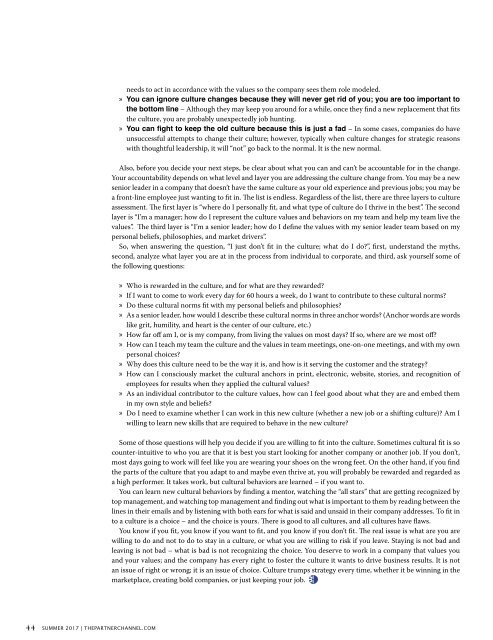The Partner Channel Magazine Summer 2017 Final 2
Finding the perfect fit isn't always easy. Whether you're looking for shoes or a Partner to take your business to the next level. This quarter's magazine covers SMART Partnerships, marketing best practices, and more.
Finding the perfect fit isn't always easy. Whether you're looking for shoes or a Partner to take your business to the next level. This quarter's magazine covers SMART Partnerships, marketing best practices, and more.
You also want an ePaper? Increase the reach of your titles
YUMPU automatically turns print PDFs into web optimized ePapers that Google loves.
needs to act in accordance with the values so the company sees them role modeled.<br />
»»<br />
You can ignore culture changes because they will never get rid of you; you are too important to<br />
the bottom line – Although they may keep you around for a while, once they find a new replacement that fits<br />
the culture, you are probably unexpectedly job hunting.<br />
»»<br />
You can fight to keep the old culture because this is just a fad – In some cases, companies do have<br />
unsuccessful attempts to change their culture; however, typically when culture changes for strategic reasons<br />
with thoughtful leadership, it will “not” go back to the normal. It is the new normal.<br />
Also, before you decide your next steps, be clear about what you can and can’t be accountable for in the change.<br />
Your accountability depends on what level and layer you are addressing the culture change from. You may be a new<br />
senior leader in a company that doesn’t have the same culture as your old experience and previous jobs; you may be<br />
a front-line employee just wanting to fit in. <strong>The</strong> list is endless. Regardless of the list, there are three layers to culture<br />
assessment. <strong>The</strong> first layer is “where do I personally fit, and what type of culture do I thrive in the best”. <strong>The</strong> second<br />
layer is “I’m a manager; how do I represent the culture values and behaviors on my team and help my team live the<br />
values”. <strong>The</strong> third layer is “I’m a senior leader; how do I define the values with my senior leader team based on my<br />
personal beliefs, philosophies, and market drivers”.<br />
So, when answering the question, “I just don’t fit in the culture; what do I do?”, first, understand the myths,<br />
second, analyze what layer you are at in the process from individual to corporate, and third, ask yourself some of<br />
the following questions:<br />
»»<br />
Who is rewarded in the culture, and for what are they rewarded?<br />
»»<br />
If I want to come to work every day for 60 hours a week, do I want to contribute to these cultural norms?<br />
»»<br />
Do these cultural norms fit with my personal beliefs and philosophies?<br />
»»<br />
As a senior leader, how would I describe these cultural norms in three anchor words? (Anchor words are words<br />
like grit, humility, and heart is the center of our culture, etc.)<br />
»»<br />
How far off am I, or is my company, from living the values on most days? If so, where are we most off?<br />
»»<br />
How can I teach my team the culture and the values in team meetings, one-on-one meetings, and with my own<br />
personal choices?<br />
»»<br />
Why does this culture need to be the way it is, and how is it serving the customer and the strategy?<br />
»»<br />
How can I consciously market the cultural anchors in print, electronic, website, stories, and recognition of<br />
employees for results when they applied the cultural values?<br />
»»<br />
As an individual contributor to the culture values, how can I feel good about what they are and embed them<br />
in my own style and beliefs?<br />
»»<br />
Do I need to examine whether I can work in this new culture (whether a new job or a shifting culture)? Am I<br />
willing to learn new skills that are required to behave in the new culture?<br />
Some of those questions will help you decide if you are willing to fit into the culture. Sometimes cultural fit is so<br />
counter-intuitive to who you are that it is best you start looking for another company or another job. If you don’t,<br />
most days going to work will feel like you are wearing your shoes on the wrong feet. On the other hand, if you find<br />
the parts of the culture that you adapt to and maybe even thrive at, you will probably be rewarded and regarded as<br />
a high performer. It takes work, but cultural behaviors are learned – if you want to.<br />
You can learn new cultural behaviors by finding a mentor, watching the “all stars” that are getting recognized by<br />
top management, and watching top management and finding out what is important to them by reading between the<br />
lines in their emails and by listening with both ears for what is said and unsaid in their company addresses. To fit in<br />
to a culture is a choice – and the choice is yours. <strong>The</strong>re is good to all cultures, and all cultures have flaws.<br />
You know if you fit, you know if you want to fit, and you know if you don’t fit. <strong>The</strong> real issue is what are you are<br />
willing to do and not to do to stay in a culture, or what you are willing to risk if you leave. Staying is not bad and<br />
leaving is not bad – what is bad is not recognizing the choice. You deserve to work in a company that values you<br />
and your values; and the company has every right to foster the culture it wants to drive business results. It is not<br />
an issue of right or wrong; it is an issue of choice. Culture trumps strategy every time, whether it be winning in the<br />
marketplace, creating bold companies, or just keeping your job.<br />
44 SUMMER <strong>2017</strong> | THEPARTNERCHANNEL.COM














